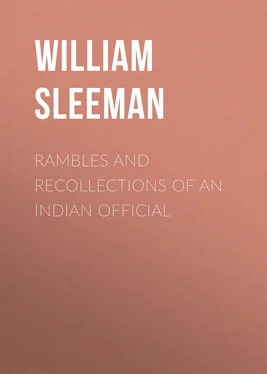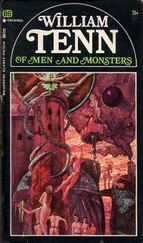William Sleeman - Rambles and Recollections of an Indian Official
Здесь есть возможность читать онлайн «William Sleeman - Rambles and Recollections of an Indian Official» — ознакомительный отрывок электронной книги совершенно бесплатно, а после прочтения отрывка купить полную версию. В некоторых случаях можно слушать аудио, скачать через торрент в формате fb2 и присутствует краткое содержание. Жанр: Путешествия и география, История, foreign_edu, foreign_antique, foreign_prose, на английском языке. Описание произведения, (предисловие) а так же отзывы посетителей доступны на портале библиотеки ЛибКат.
- Название:Rambles and Recollections of an Indian Official
- Автор:
- Жанр:
- Год:неизвестен
- ISBN:нет данных
- Рейтинг книги:4 / 5. Голосов: 1
-
Избранное:Добавить в избранное
- Отзывы:
-
Ваша оценка:
- 80
- 1
- 2
- 3
- 4
- 5
Rambles and Recollections of an Indian Official: краткое содержание, описание и аннотация
Предлагаем к чтению аннотацию, описание, краткое содержание или предисловие (зависит от того, что написал сам автор книги «Rambles and Recollections of an Indian Official»). Если вы не нашли необходимую информацию о книге — напишите в комментариях, мы постараемся отыскать её.
Rambles and Recollections of an Indian Official — читать онлайн ознакомительный отрывок
Ниже представлен текст книги, разбитый по страницам. Система сохранения места последней прочитанной страницы, позволяет с удобством читать онлайн бесплатно книгу «Rambles and Recollections of an Indian Official», без необходимости каждый раз заново искать на чём Вы остановились. Поставьте закладку, и сможете в любой момент перейти на страницу, на которой закончили чтение.
Интервал:
Закладка:
The general horizontality of the Deccan trap over an area of not less than 200,000 square miles, and the absence of volcanic hills of the usual conical form, are difficulties which have caused much discussion. Some of the 'old volcanic vents' appear to have existed near Poona and Mahāblēshwar. The entire area has been subjected to sub-aerial denudation on a gigantic scale, which explains the occurrence of the basalt as the caps of isolated hills. Much further investigation is required to clear up details ( Manual of the Geology of India , ed. 1, Part I, chap. 13)
198
The author took charge of the Jubbulpore District in March 1828.
199
The fossiliferous beds near Jubbulpore, described in the text, seem to belong to the group now classed as the Lamētā beds. The bones of a large dinosaurian reptile (Titanosaurus indicus ) have been identified ( I.G. , 1907, vol. i, p. 88).
200
'Many years ago Dr. Spry (Note on the Fossil Palms and Shells lately discovered on the Table-Land of Sāgar in Central India , in J.A.S.B. for 1833, vol. ii, p. 639) and, subsequently to him, Captain Nicholls ( Journal of Asiatic Soc. of Bombay , vol. v, p. 614), studied and described certain trunks of palm-trees, whose silicified remains are found imbedded in the soft intertrappean mud-beds near Sāgar. . . . The trees are imbedded in a layer of calcareous black earth, which formed the surface soil in which they grew; this soil rests on, and was made up of the disintegration of, a layer of basalt. It is covered over by another and similar layer of the same rock near where the trees occur. . . . The palm-trees, now found fossilized, grew in the soil, which, in the condition of a black calcareous earthy bed, we now find lying round their prostrate stems. They fell (from whatever cause), and lay until their silicification was complete. A slight depression of the surface, or some local or accidental check of some drainage- course, or any other similar and trivial cause, may have laid them under water. The process of silicification proceeded gradually but steadily, and after they had there, in lapse of ages, become lapidified, the next outburst of volcanic matter overwhelmed them, broke them, partially enveloped, and bruised them, until long subsequent denudation once more brought them to light' (J. G. Medlicott, in Memoirs of the Geological Survey of India , vol. ii. Part II, pp. 200, 203, 204, 205, 216, as quoted in C. P. Gazetteer (1870), p. 435). The intertrappean fossils are all those of organisms which would occur in shallow fresh-water lakes or marshy ground.
Besides the author's friend and relative, Dr. H. H. Spry, Dr. Spilsbury contributed papers on the Nerbudda fossils to vols. iii, vi, viii, ix, x, and xiii of the J.A.S.B. Other writers also have treated of the subject, but it appears to be by no means fully worked out. James Prinsep, to whom no topic came amiss, discussed the Jubbulpore fossil bones in the volume in which Dr. Spry's paper appeared. Dr. Spry was the author of a work entitled Modern India: with Illustrations of the Resources and Capabilities of Hindustan (2 vols. 8vo, 1838). He became F.R.S.
201
The garrison is stated in the Gazetteer (1870) to consist of a European regiment of infantry, two batteries of European artillery, one native cavalry and one native infantry regiment. In 1893 it consisted of one battery of Royal Artillery, a detachment of British Infantry, a regiment of Bengal Cavalry, and a detachment of Bengal Infantry. According to the census of 1911, the population of Sāgar was 45,908.
202
The Banjāras, or Brinjāras, are a wandering tribe, principally employed as carriers of grain and salt on bullocks and cows. They used to form the transport service of the Moghal armies, and of the Company's forces at least as late as 1819. Their organization and customs are in many ways peculiar. The development of roads and railways has much diminished the importance of the tribe. A good account of it will be found in Balfour, Cyclopaedia of India , 3rd ed., 1885, s. v. 'Banjāra'. Dubois ( Hindu Manners, &c. , 3rd ed. (1906), p. 70) states that 'of all the castes of the Hindus, this particular one is acknowledged to be the most brutal'.
203
See note on human sacrifice, ante , Chapter 8, note 8.
204
In the Hoshangābād district of the Central Provinces. The sandstone formation here attains its highest development, and is known to geologists as the 'Mahādēo sandstones'. The new sanitarium of Pachmarhī is situated in these hills.
205
It has been long since suppressed.
206
Benares is the principal seat of the worship of Mahādēo (Siva), but his shrines are found everywhere throughout India. One hundred and eight of these are reckoned as important. In Southern India the most notable, perhaps, is the great temple at Tanjore (see chap. 17 of Monier Williams's Religious Thought and Life in India ).
207
'This mode of suicide is called Bhrigu-pātā, "throwing one's self from a precipice". It was once equally common at the rock of Girnār [in Kāthiāwār], and has only recently been prohibited' (ibid. p. 349).
208
Nagpore (Nāgpur) was governed by Marāthā rulers, with the title of Bhōnslā, also known as the Rājās of Berār. The last Rājā, Raghojī, died without heirs in 1853. His dominions were then annexed as lapsed territory by Lord Dalhousie. Sir Richard Jenkins was Resident at Nāgpur from 1810 to 1827. Nāgpur is now the head-quarters of the Chief Commissioner of the Central Provinces.
209
'There is a legend that Siva appeared in the Kali age, for the good of the Brahmans, as "Sveta", "the white one", and that he had four disciples, to all of whom the epithet "Sveta" is applied' (Monier Williams, Religious Thought and Life in India , p. 80, note 2). Various explanations of the legend have been offered. Professor A. Weber is inclined to think that the various references to white teachers in Indian legends allude to Christian missionaries. The Mahābhārata mentions the travels of Nārada and others across the sea to 'Sveta-dwīpa', the 'Island of the White Men', in order to learn the doctrine of the unity of God. This tradition appears to be intelligible only if understood to commemorate the journeys of pious Indians to Alexandria, and their study of Christianity there ( Die Griechen in Indien , 1890, p. 34).
210
The Rāmlīlā, a performance corresponding to the mediaeval European 'miracle-play', is celebrated in Northern India in the month of Kuār (or Asvin, September-October), at the same time as the Durgā Pūjā is solemnized in Bengal. Rāma and his brother Lachhman are impersonated by boys, who are seated on thrones in state. The performance concludes by the burning of a wicker image of Rāvana, the demon king of Lankā (Ceylon), who had carried off Rāma's queen, Sitā. The story is the leading subject of the great epic called the Rāmāyana.
211
The Lathyrus sativus is cultivated in the Punjab and in Tibet. Its poisonous qualities are attributed to its excessive proportion of nitrogenous matter, which requires dilution. Another species of the genus, L. cicer , grown in Spain, has similar properties. The distressing effects described in the text have been witnessed by other observers (Balfour, Cyclopaedia , 3rd ed., 1885, s.v. 'Lathyrus').
Читать дальшеИнтервал:
Закладка:
Похожие книги на «Rambles and Recollections of an Indian Official»
Представляем Вашему вниманию похожие книги на «Rambles and Recollections of an Indian Official» списком для выбора. Мы отобрали схожую по названию и смыслу литературу в надежде предоставить читателям больше вариантов отыскать новые, интересные, ещё непрочитанные произведения.
Обсуждение, отзывы о книге «Rambles and Recollections of an Indian Official» и просто собственные мнения читателей. Оставьте ваши комментарии, напишите, что Вы думаете о произведении, его смысле или главных героях. Укажите что конкретно понравилось, а что нет, и почему Вы так считаете.












